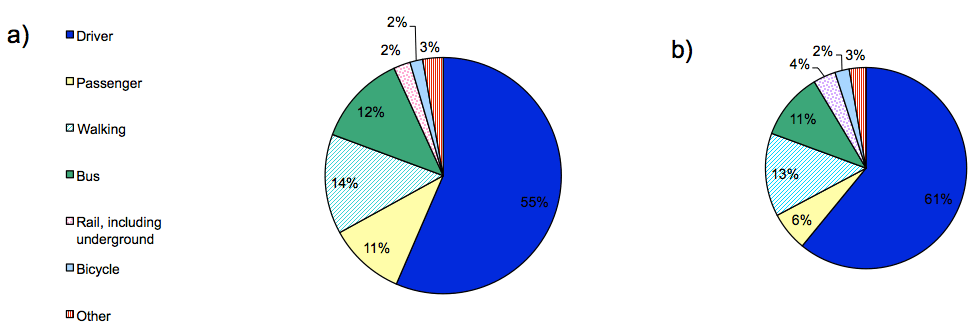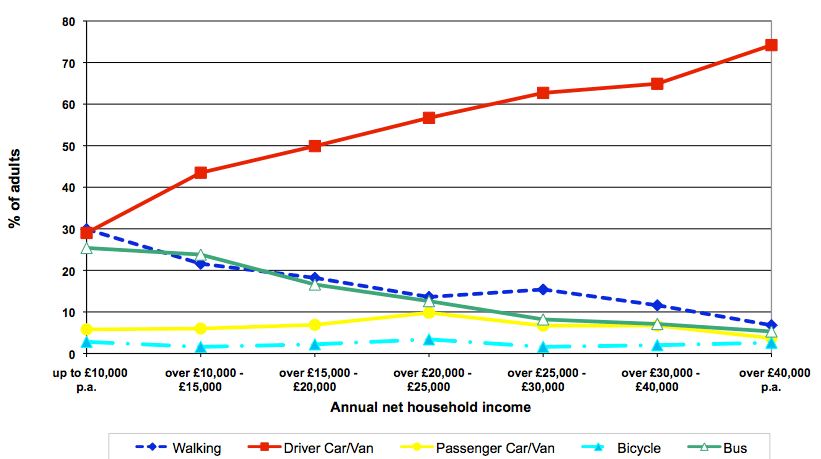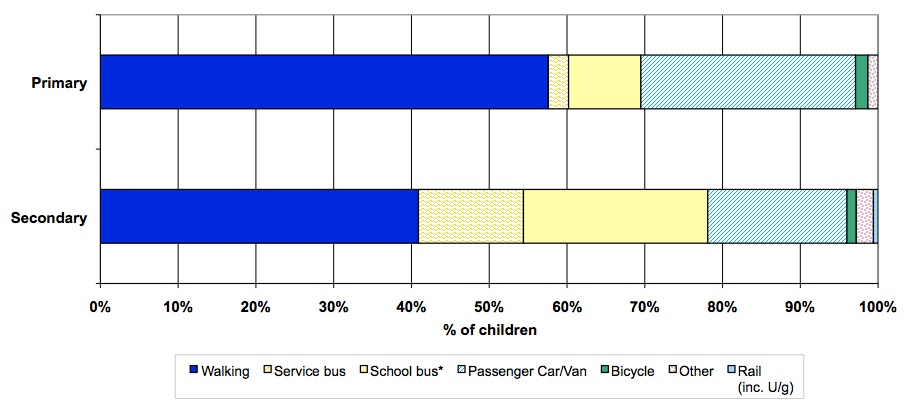Transport and Travel in Scotland 2010
Summarises a broad range of transport statistics including road vehicles, traffic, casualties, bus and rail passengers, road and rail freight, air and water transport and personal travel as well as providing some comparisons with GB figures. Further breakdowns of Scottish Household Survey transport data including households' access to cars and bikes, frequency of driving, modes of travel to work and school, use and opinions of public transport and access to services are also presented.
6 Travel to work and school
- Sixty-seven per cent of respondents travelled to work by car, a similar percentage to 2000. Sixty-one per cent of these were as a driver and six per cent as a passenger.
- Active travel accounted for 16 per cent (walking: 13.4%, cycling: 2.3%) and public transport 14 per cent (bus: 10.8%, rail: 3.6%) of all journeys to work in 2010.
- Females were more likely to walk or travel by bus to work than males, while males were more likely to drive to work than females.
- Forty-five per cent of car drivers and 35 per cent of passengers experienced delays to work at least once a week due to traffic congestion.
- Around a quarter of respondents regularly travelled to work using different modes on different days in 2009/10.
- Fifty-one per cent of all journeys to school were made by walking or cycling in 2010 (down from 55% in 2000) .
- Children in primary school were more likely to walk or be driven to school than children in secondary school .
Travel to work
6.1 The SHS travel to work data underpin Scotland's National Indicator on travel to work. More information on National Indicators can be found on the Scotland Performs website [2].
6.2 Ten per cent of employed adults worked from home in 2010. Although this has been fairly stable since 2005, it is still an increase of 3 percentage points since 1999. [ Table S3]
Mode of travel
6.3 In 2010, 67 per cent of adults travelled to work by car. Although there has been no change in the percentage travelling to work by car since 2000, there has been an increase in those driving, rather than being a passenger, with the percentage of those travelling as passengers falling from 11 per cent in 2000 to 6 per cent in 2010. This is likely to be due to increased access to cars and the number of households with more than one car since 2000. (Figure 18)
Figure 18: Travel to work a) 2000 and b) 2010

6.4 Eleven per cent of adults travelled to work by bus and 3.6 per cent travelled by rail. These numbers have remained relatively stable since 2000. [ Table S3]
6.5 Thirteen per cent of adults travelled to work on foot in 2010. This figure has been relatively stable since 2000. The number of adults cycling to work was 2.3 per cent, comparable with the previous two years. [ Table S3]
Gender and household composition
6.6 Respondents' methods of travelling to work were dependent on gender, with females more likely to walk than males (16% and 11% respectively), while males were more likely to drive to work than females. [ Table 6]
6.7 Single parent families were the most likely to walk to work or take the bus with small families being the most likely to drive.
Employment status and income
6.8 Self employed people were less likely travel to work by bus, and part time workers were more likely to walk, which may be due to part time workers being more likely to live close to their place of work.
6.9 As household income increases respondents were more likely to drive to work and less likely to walk or take the bus. (Figure 19)
Figure 19: Main method of travel to work by annual net household income, 2010

Urban/rural and car ownership
6.10 Those living in large urban areas were more likely to use public transport to get to work (23% compared to the average for all adults of 14%), which is likely to be due to the increased accessibility and frequency of public transport services in these areas.
6.11 The more cars a household had access to the greater the likelihood of them driving to work. Those households with no cars generally took the bus (41%) or walked to work (34%). [ Table 6]
Congestion
6.12 Seventy per cent of those driving to work or travelling by bus had their journey delayed by congestion with just under half experiencing congestion at least once a week. Around 60 per cent allowed an extra 5 to 30 minutes travel time for their journey. [ Table 7]
Multi purpose trips
6.13 Journeys home from work were far more likely to be combined with other trips than those to work. Taking children to school was the most common task undertaken on the way to work whilst taking spouse/partner home from work was the most likely on the journey home. [ Table 8]
Car sharing and travel plans
6.14 Fourteen per cent of respondents were involved in a car sharing arrangement in 2007-2010. The vast majority (88%) of these were arranged informally. The most common reason given for not car sharing was 'nobody in work lives near me' and 'sharing with a friend or neighbour' was cited as most likely to encourage people. [ Table 10]
6.15 Thirteen per cent of respondents said that their workplace had a travel plan. [ Table 11]
Changes to mode of travel
6.16 Most people had not changed their mode of travel for their journey to work from the previous year. Car/van drivers were the least likely to do this with 96 per cent of those using this method the previous year continuing to do so. Those who travelled by rail the previous year are least likely (except for those using 'other' modes) to continue to use this method of travel (19% changed to another mode). Car/van is the most popular mode that people have changed to. [ Table 9]
6.17 Fifty-seven per cent of those travelling to work by car/van said it would not be possible for them to travel to work by public transport. The most common reason being given was 'no direct route'. For those who could use public transport but chose not to, 'Takes too long' was the most popular reason cited. [ Table 13]
6.18 The most common reasons cited for not cycling to work were 'do not have a bike' (38%), and 'too far to cycle' (30%), followed by 'weather' (15%), 'too many cars' (13%) and 'traffic too fast' (11%). For those who said they did not have a bike, the most common reasons (excluding 'Other') were 'too many cars on the road' and 'can't ride a bike'. [ Table 25]
6.19 Around a quarter of respondents regularly travelled to work using different modes on different days in 2009/10. Those who usually drove to work were least likely to use an alternative mode with 16 per cent citing another method (most commonly walking or bus). Those travelling by bicycle were most likely to use alternative ways of travelling to work with the most popular being driving and walking respectively. This may be due to differing working patterns, weather conditions and participation in recreational activities.
GB comparisons
6.20 Ten per cent of employed adults worked from home in 2010. The GB figures in the NTS10 show 5 per cent of employed adults always work from home. The higher figures seen in Scotland may be due to the less accessible landscapes found in Scotland, which make it more difficult to travel to a workplace.
6.21 The Labour Force Survey ( LFS) shows that over the years the percentage of people travelling to work by car has tended to be slightly lower in Scotland than in Great Britain as a whole, and the percentage using public transport has tended to be slightly higher in Scotland than in Great Britain. According to the LFS, in Autumn 2010, 71 per cent of people travelling to work in Scotland and 70 per cent in GB did so by car and 14 per cent used public transport (compared with 15% for GB). The year-to-year fluctuations, and any differences from the results of the SHS, are likely to be due to sampling variability.
6.22 GB figures from the NTS10 show walking accounts for 10 per cent of commuting trips, which is similar to the SHS 2010 figure of 13 per cent of people who walk to work.
Travel to school
6.23 Half of journeys to school were made on foot in 2010. This has fallen 4 percentage points since 2000. (Figure 20) As walking journeys have fallen, those being driven to school have increased. [ Table S3]
Figure 20: Mode of transport to school a) 2000 and b) 2010

6.24 How children travel to school is dependent on their age. Children in primary school, aged between 4-11, were more likely to walk or be driven to school than children in secondary, aged between 12-18. Secondary school children were more likely to take the bus than those in primary school. (Figure 21) This is likely to be partly due to primary schools generally being closer than secondary schools, therefore people are more likely to walk, but also, many respondents from the survey indicated that they felt primary school children were too young to travel on public transport on their own. [ Table 14]
Figure 21: Mode of transport to school by school type, 2010

6.25 Over half of children in towns and urban areas walked to school in 2010. Children in rural areas were much less likely to walk to school and tended instead to travel by school bus. This service is less widely available in large urban areas, where 11 per cent of children used a service bus to get to school. [ Table 14]
6.26 For those children who walked to school, 84 per cent stated the reason for walking was that the school was nearby. Those taking the bus and car cited convenience as the reason for mode choice, with many feeling that it was too far to walk and car travel was both the safest and quickest mode of travel. [ Table 15]
6.27 The vast majority of pupils used the same method to travel both to and from school.
GB comparisons
6.28 The results are broadly consistent with those as found in the NTS, particularly for bus and bicycle travel ( NTS: 22% and 2% respectively, SHS: 24% and 1% respectively). It should be noted that NTS methodology differs slightly and there is a different geographical coverage between this and the SHS - the NTS excludes school journeys greater than 50 miles and the Scottish Islands are excluded from the sample.
There is a problem
Thanks for your feedback